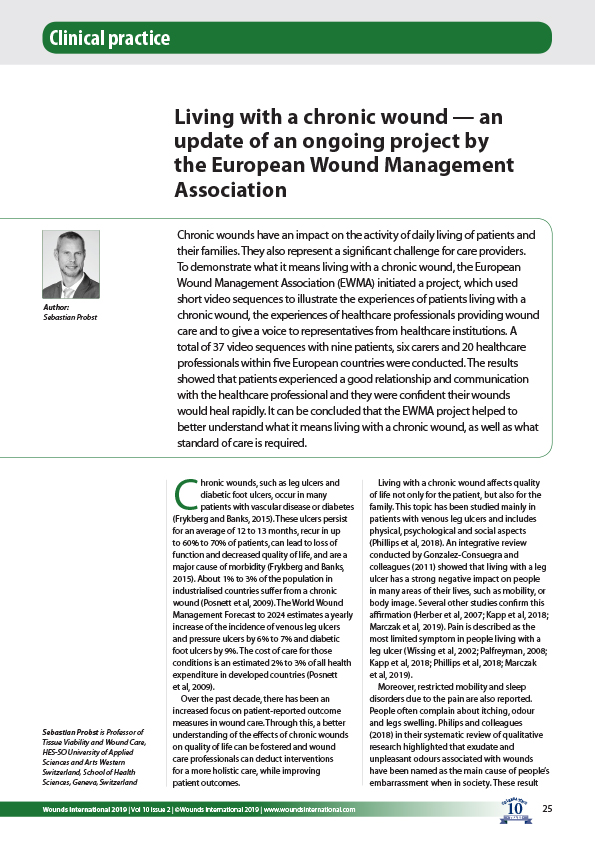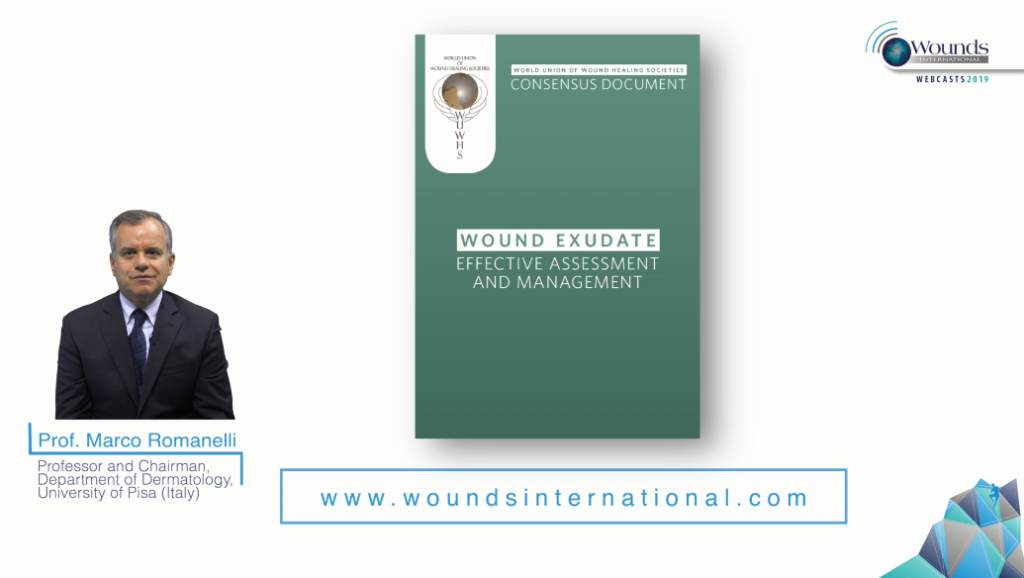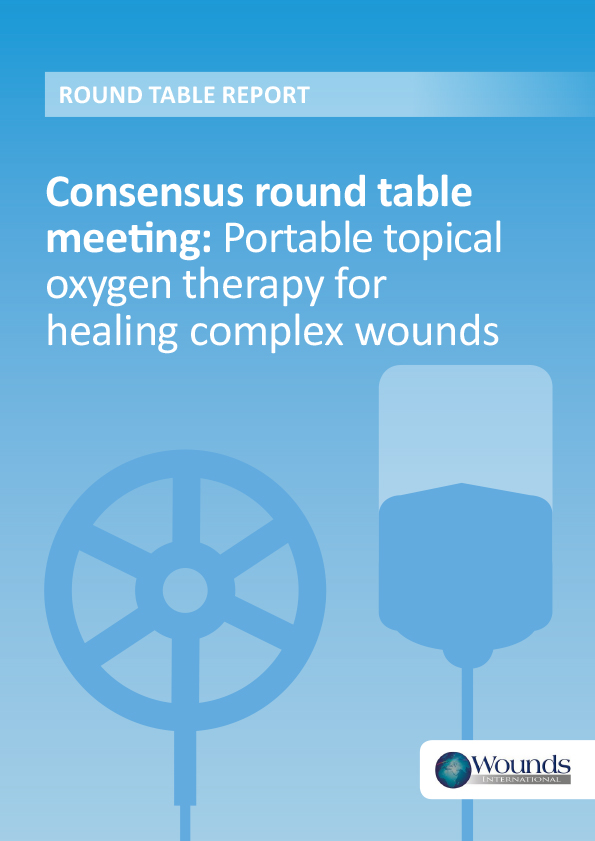Creating a unified approach to best practice in wound care

Stem cells and growth factors in healing the diabetic foot ulcer

Living with a chronic wound — an update of an ongoing project by the European Wound Management Association

Using the new T.I.M.E. Clinical Decision Support Tool to promote consistent holistic wound management and eliminate variation in practice at the Cambourne Medical Clinic, Australia: Part 1

Undisturbed wound healing: a narrative review of the literature and clinical considerations

Clinical challenges and therapeutic updates in wound exudate

The first Wounds International webcast of 2019, chaired by Professor Marco Romanelli, focuses on the recommendations from the new WUWHS consensus document “Wound exudate: effective assessment and management”. To view the live day questions and answers click here For further infomation from Hartmann click here To read the Executive Summary click here
Impact of lymphovenous anastomosis on limb circumference in patients with lymphoedema tarda

Periodontal disease and chronic wounds: the theory of wound focal infection in a modern context

Skin barrier restoration upon topical use of two 5% dexpanthenol water-in-oil formulations on freshly tattooed skin: results from a single-blind prospective study

Mepilex® Border Flex — results of an observational study in German specialist wound care centres

NATROX® Oxygen Wound Therapy: a vital element in wound healing

Looking back on a decade of Wounds International and looking forward to the next 10 years

10 years of wounds — progress or stagnation?

The roles of infrared thermography in pressure ulcer research with focus on skin microclimate induced by medical devices and prophylactic dressings

The challenges and opportunities of developing diabetic footcare in Cambodia

Surfactants and their role in biofilm management in chronic wounds

WUWHS Consensus Document: Wound Exudate, effective assessment and management
Exudate plays a key role in wound healing. However, exudate can delay healing when in the wrong amount, in the wrong place, or of the wrong composition. Effective assessment and management of exudate is therefore key to ensuring timely wound healing without complications. Since the World Union of Wound Healing Societies (WUWHS) last issued guidance […]
WUWHS Consensus Document – Wound Exudate, effective assessment and management

Exudate plays a key role in wound healing. However, exudate can delay healing when in the wrong amount, in the wrong place, or of the wrong composition. Effective assessment and management of exudate is therefore key to ensuring timely wound healing without complications. Since the World Union of Wound Healing Societies (WUWHS) last issued guidance […]
Development of best clinical practice guidelines for epidermolysis bullosa
Epidermolysis bullosa (EB) is a rare genetic skin fragility disorder and the majority of patients live with life-long wounding. EB is not specific to any racial group and those affected by the disorder can be found all over the world. In contrast with many other countries, the UK is fortunate to have well-developed specialist services […]
The benefit of PICO™ Single Use NPWT System to reduce surgical site complications: summary of a meta-analysis with implications for clinical practice
A simplified summary of a meta-analysis is described in this article, which shows the ability of a PICO™ Single Use Negative Pressure Wound Therapy System (Smith & Nephew) to reduce surgical site complications, including surgical site infection, dehiscence and length of stay.
Development of guidelines for pressure ulcer prevention
Evidence-based pressure ulcer (PU) prevention guidelines were developed for a Southern California regional medical centre following what were concerning 1-day prevalence survey results. A previous focus had been placed on treatment of PUs with little education and policy related to prevention. After familiarising staff with the new guidelines and providing education, the results of the […]
Prospective surveillance with bioelectrical impedance to guide early treatment of breast cancer-related lymphoedema
Introduction: Early detection and treatment of upper-limb lymphoedema following axillary surgery for breast cancer can reduce symptomatic disease. Bioimpedance spectroscopy (BIS) can be used to identify increased extracellular fluid volume. Aim: The aim of this study was to determine the rates of lymphoedema identified by prospective surveillance with BIS and the effects of early identification on patient […]
Clinical innovation: fish-derived wound product for cutaneous wounds
Recent research suggests that wound care products derived from fish skin could improve cutaneous wound healing. A PubMed search and extended literature search identified 392 articles relating to such research. Evidence indicates that fish-derived scaffold materials are biocompatible, biodegradable and do not require frequent dressing change. It also provides properties that could accelerate wound healing, offer antibacterial […]
Understanding the acceptability and feasibility of a regional lymphoedema surveillance programme: a pilot study
Background: Lymphoedema is a common complication for breast cancer survivors. Early detection and treatment reduces costs and improves outcomes. Aim: To determine the acceptability and feasibility of a lymphoedema surveillance programme (LSP) for breast cancer patients and breast clinic staff in rural and regional areas. Methods: All patients diagnosed with breast cancer were invited to […]
Understanding clinical practice challenges: a survey performed with wound care clinicians to explore wound assessment frameworks
TIME (Tissue, Inflammation, Moisture, Edges) and other similar wound assessment tools are based on the concept of wound bed preparation. A survey was developed to explore the role and utility of wound assessment tools in current wound care practice. The survey was answered by attendees of the European Wound Management Association (EWMA) 2018 conference in […]
Focus on limb salvage in the diabetic foot
This article is based on an advisory board meeting, which was held in London on 27th June 2018, and sponsored by Integra LifeSciences. The expert group was convened to discuss the use of the Integra LifeSciences product portfolio in the diabetic foot, with a focus on limb salvage and creating an appropriate pathway of care […]
Wounds digest
In this section, a brief synopsis is presented of a range of recently published articles that may be of interest to healthcare professionals working in the wound care setting. The aim of this round-up is to provide an overview, rather than a detailed summary and critique, of the research papers selected. Full references are provided […]
It’s all about processes, protocols and having a strategy
Believe it or not, there is a process that accompanies the publication of this esteemed journal. First, comes the commissioning: a broad range of wound care experts from across the globe are approached to maintain that Wounds International continues to provide you, the reader, with the most valuable and up-to-date articles in wound care. Next […]
Evolution of the wound infection continuum
In 2016, the International Wound Infection Institute reviewed the wound infection continuum through a literature review and formal Delphi process. This article discusses some significant changes made to the wound infection continuum, including changes in terminology used to describe phases of wound infection, and distinction between early (covert) signs of local infection and the overt […]
An evaluation on the use of adjustable compression wrapping devices as an alternative to compression bandaging in lower leg wounds
An evaluation of the use of an adjustable compression wrap (easywrap®, Haddenham Healthcare) was conducted within a UK-based wound healing clinic. The aim was to investigate if this adjustable compression wrapping device (ACWD) was a cost-effective alternative to short-stretch, combination short-stretch and long-stretch compression bandage kits for patients with chronic oedema and lower leg wounds. […]
Consensus round table meeting: Portable topical oxygen therapy for healing complex wounds

Oxygen is critical to wound healing. Lack of oxygen (hypoxia) can delay healing and increase the risk of complications. In patients with comorbidities, their complex and chronic wounds are at increased risk of hypoxia, which means that healing is delayed, but may be corrected by early intervention with topical oxygen therapy. NATROX® Oxygen Wound Therapy […]
Challenging wounds, improving outcomes; Biofilm management with topical oxygen therapy

Evidence has proven the positive effects of topical oxygen therapy on chronic, hard-to-heal wounds (Harding, 2016). It is becoming widely accepted that hard-to-heal wounds contain biofilm and that the presence of biofilm delays and/or prevents healing (WUWHS, 2016). The aim of this document is to inform practitioners about the issue of biofilm and how […]
Made Easy: Managing skin tears with Adaptic Touch™ Dressing

Skin tears are a significant problem for those with fragile skin but with appropriate skin management, they are mostly, although not always, preventable. This Made Easy covers the assessment, diagnosis and management of skin tears. Products from the KCI – an Acelity company dressing portfolio have been used as examples. Supported by KCI – An Acelity […]
Role of bacteria and biofilms in non-healing wounds — Karen Cross

In the first presentation, Karen Cross, (St Michaels, Canada), will discuss the design and outcomes of the NATROX® study, investigating the impact of NATROX® Oxygen Therapy on non-healing wounds, and particularly on non-healing wounds where biofilm is present.
Role of bacteria and biofilms in non-healing wounds — Julie Perry

In this presentation, Julie Perry, (St Michaels, Canada), will look in depth at the formation and structure of biofilm and how this affects wound healing. She will explain strategies for biofilm eradication and guidance to how this can be applied in practice, focusing on the role of oxygen in wound healing.
Role of bacteria and biofilms in non-healing wounds — the summary

This Wounds International webcast will inform practitioners about the issue of biofilm and how it affects wound chronicity, as well as how topical oxygen therapy may help to kickstart stalled healing. The NATROX® study has shown that topical oxygen therapy has a positive effect on biofilm in chronic wounds, and this webcast will provide practical […]
Feeling the pressure
It is all change here in Yorkshire as the heady days of summer, which broke records in the UK for sustained glorious temperatures, have been replaced by the more common sight of grey skies and cold temperatures as autumn sets out its stall. And in my continuing vein of tenuous links, it is all change […]
Meeting report: Go beyond: A multidisciplinary approach for the management of diabetic foot ulcers
Meeting report: Novel technology for advanced wound dressings — first clinical outcomes from an international multi-disciplinary perspective
Remove barriers to healing: Focus on wound bed preparation
Meeting report: The gap challenge in clinical practice — how do you manage it?
Best practice recommendations for the prevention and management of skin tears in aged skin: an overview
Using Integra Dermal Regeneration Template Single Layer Thin in practice
Optimising quality of life for people with non-healing wounds
Ten top tips: palliative wound care
The role of secondary hemorheological disorders in the pathophysiology of leg ulcers in several clinical conditions
The Sub-Epidermal Moisture Scanner: the principles of pressure injury prevention using novel early detection technology
Seborrheic dermatitis treatment with natural honey
Moving the chronic wound along the healing trajectory
Role of oxygen in wound healing Breda Cullen

This Wounds International webcast focuses on the role of oxygen in wound healing and how topical oxygen therapy can improve oxygenation and, therefore, healing. In this presentation, Breda Cullen, Research and Development Director, UK, outlines the vital role that oxygen plays throughout the healing process and the impact that lack of oxygen (hypoxia) can have on […]


